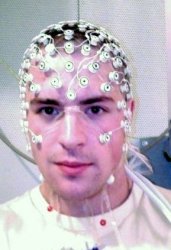Can you electronically enhance your brain? I’m not talking about surgically turning into a Borg. But are there electronic methods that can improve various functions of your brain? Fans of brainwave entrainment say yes.
There was an old recruiting ad for electrical engineers that started with the headline: The best electronic brains are still human. While it is true that even a toddler can do things our best computers struggle with, it is easy to feel a little inadequate compared to some of our modern electronic brains. Then again, your brain is an electronic device of sorts. While we don’t understand everything about how it works, there are definitely electric signals going between neurons. And where there are electric signals there are ways to measure them.
The tool for measuring electric signals in the brain is an EEG (electroencephalograph). While you can’t use an EEG to read your mind, exactly, it can tell you some pretty interesting information, such as when you are relaxed or concentrating. At its most basic we’ve seen toys and simple hobby projects that purport to be “mind controlled” but only at an incredibly rudimentary level.
Brainwave entrainment is a hypothesis that sending low frequency waves to your brain can give your mind a nudge and sync up brain activity with the equipment measuring it. The ability to synchronize with the brain could yield much better measurements for a meaningful interface between modern electronics and electric storm of thought happening in your head.

Keeping the Measurement on the Outside
When Hans Berger took the first human EEG in 1924, he built on 50 years of research about electrical brain activity in monkeys, dogs, and rabbits. It was known that placing electrodes directly on an animal’s brain produced signals that changed if, for example, you changed the light level in the room. Of course, you couldn’t pop the top on a human subject and wedge electrodes in their brain, so Berger had to be more subtle.
An EEG has several frequency bands where your brain produces repeating waves. The alpha band (8-15 Hz) occurs when relaxing or with eyes closed, for example. beta waves (16-31 Hz) occur when you are focused, alert, or anxious. You can find a nice table of the waves and what they seem to indicate on Wikipedia.
Here’s where things get tricky. If your brain produces, say, alpha waves when you are relaxed, can you impose alpha waves on your brain to make you relax? That idea is known as brainwave entrainment.
Entrainment is known to happen in regular systems. Christiaan Huygens reported in 1665 that several pendulum clocks in close proximity eventually synchronized. This is due to energy from each clock affecting the other clocks. When out of phase, the effect is negative. When in phase, the effect is positive, so over time, the pendulums are all in phase — you can see this effect (exacerbated by using a moving platform) in the video below.
The idea is that if you can impress sound waves at a particular frequency on your brain, it will cause your brain to sync up just like the pendulums in the video. This might sound silly, but EEG evidence seems to bear it out and it even has a name: FFR or frequency following response. This happens unintentionally sometimes. For example, music or chanting can produce changes in the EEG, presumably from this same effect.
Nudging Brainwaves Using Audio
One issue with trying to entrain brainwaves is that the frequencies of interest are so low. There are a few methods commonly used. One idea is binaural beats. Suppose you want the brain to get an 8 Hz signal. That’s hard to do with a sound card. But it is easy to send one ear a, say 250 Hz signal and the other ear a 258 Hz signal. The brain will mix these frequencies and you will hear an 8 Hz signal (along with the other two and a 508 Hz tone, too).
 Another method is isochronic tones, were you hear bursts of a higher frequency sound and the bursts are at the lower frequency. With the binaural system, you should really use headphones. While headphones are always good, the isochronic tones don’t require them.
Another method is isochronic tones, were you hear bursts of a higher frequency sound and the bursts are at the lower frequency. With the binaural system, you should really use headphones. While headphones are always good, the isochronic tones don’t require them.
While it is a little scary to mess with your brain, you have to figure that just listening to some tones shouldn’t have much potential to mess anything up permanently. It’s a world away from inserting some electrodes in your brain, but we have looked at instances where external stimuli will have a lasting effect. Examples include how you perceive color after exposure to the McCollough Effect, and how flashing lights have the ability to trigger seizures in some people.
Pseudoscience, at Least for Now
I know, this sounds like pseudoscience. There have been some studies, but I don’t know of any that are solid and widely accepted by the mainstream scientific community. Still, it’s not inconceivable that external influences could sync up something in the brain. For example, light flashes can trigger seizures in some people. Certain kinds of music, chants, or drum beats are known to affect people in different ways. So the link between sound and your brain state isn’t that hard to imagine.
There is some evidence that when we talk to others our brains synchronize, which is another thing that sounds crazy but is apparently true. While it isn’t quite entrainment, scientists recently used similar techniques to let people communicate brain-to-brain by looking at LEDs flashing at different frequencies. The result was a multiplayer Tetris game where the players were mind-melded.
Citizen Science and Entrainment
This is an area where a large coordinated citizen science effort could make some interesting and relevant contributions. Producing tones is easy. Here’s a generator for isochronic tones and another for binaural. It would be interesting to design a little experiment. For example, consider Web Sudoku. Sudoku is a fun game that is mentally challenging but pretty easy to learn. It would be interesting to try a few games with no entrainment, a few games with perhaps headphones in silence, and a few games with headphones and a concentration tone using one of the above generators. My first cut at a list of data to collect would be:
- Time of day
- Level of difficulty
- Type of entrainment used (isochronic or binaural and at what settings)
- Number of games played in this session
- Headphone use (yes or no)
- Result (time to succeed or time when you gave up)
I set up a project for this on Hackaday.io. If you are interested, join and we’ll design some experiments and collect some data. Would the time of day matter? It seems like you’d use the “normal” plays as a baseline to see how variable your times are game-to-game. Share your thoughts here or on the Hackaday.io project.
Does it Work?
The human body — and the brain in particular — is pretty strange. So this might work the way people think. Or it could be a placebo effect. I might be able to tell you that putting a copper coin under your armpit will improve concentration and because of the placebo effect, it just might. Or perhaps it is just baloney.
However, you have the tools to find out if it works for you, even if you can’t prove why it works. There are plenty of ways to wire up an EEG, by the way, if you want to be even more rigorous. We’ve even seen a doggy EEG recently.
















Fyi isochronic.io is the home for the best Android app for these kind of frequencies.
Bah, misread the title – thought this was a chance to hack Brian in an entertaining way.
Now I’m suddenly thinking of hacking Brian Blesseds brain…..that could be entertaining, right?
Well as long as he doesn’t end up mistaking us for a polar bear.
People do that, I am looking for evidence.
https://www.wnycstudios.org/story/bringing-gamma-back
Radiolab episode about light/brain stimulation of microglia in Alzheimers’ patients.
This is ridiculously pseudoscientific and quacky. I get that you lampshaded it with several ‘this might be charlatanism, but hey, who knows? haha’ disclaimers but that really won’t be fooling anyone. Anyone else reading this please be discerning.
Amazing what is coming out more and more:
https://www.youtube.com/watch?v=kQZ7zp50gpM
Though, as usual just like a spectrometer…. if no one understands what the spectrometer graph means… then they will not be capable of performing a deductive analysis and most definitely not be capable of performing an inductive prediction of what a spectrometers graph of a molecules spectrum will look like based on a molecular energy state calculation.
https://en.wikipedia.org/wiki/Energy_level#Molecules
Uh, yeah… most don’t have a PChem course let alone a BioPChem course (I bought the BioPChem book for self study and that wasn’t a great idea).
Adjectives are not an arguement.
ALthough the title states Neurohacking Alzheimers, there is much to implicate this method will also have an effect on cognitive function.
https://www.youtube.com/watch?v=EuSMHIM1zRI
Gallium is the cure for Alzheimers according to recent studies.
Here’s a collection of various binaural beats for your listening pleasure: http://jerrywhiting.com/binaural-beats/
Transcranial current stimulation looks more promising:
Brainwave Synchronization Reverses Age-related Decline in Working Memory https://www.nature.com/articles/s41593-019-0371-x
It is a very common misconception that the placebo effect is baloney, but the science seems both well established and objective.
Regardless, this seems to be less effective than traditional meditation. Audio doesn’t seem to couple all that directly.
I’m not going to get excited unless I see some electrodes, or magnets.
Great article. Reminds me of people thinking the non destructive with zero prep FT-NIR system methods I developed, validated and implemented holistically were voodoo.
As some say the Devil is in the details and probably because the secretive devilish are desperate to find the details that do logically quantitatively exist even if only used for identification methods… you hope at least when low dose threshold is critical for healthy effect. There are the issues with malicious use of technology that I see the OpenWater Company Mary Lou Jepsen has talked about in regards to social issues that need to be ironed out before implementation:
https://www.openwater.cc/technology
I’ve always liked being overt and at the most… not wanting to elaborate or discuss the topic I think due to the Wesleyan baptism public notice I made. I don’t like secrets.
There are and used to be better presentations regarding “mind reading” and there is one or two crude demonstrations of what Berkeley has hacked into regarding Cats and Humans vision signals to recreate what the eye is seeing. I’ve posted on Hackaday before and you can search “Getting visual data from a cat’s brain in realtime (TechnoCalyps)” and “Vision Reconstruction” on Youtube. However, most are using some form of NMR looks like.
Figure there are AC and DC characteristics within critical thresholds to entrain/process input and Analog and Digital signals with a coding method that is adaptive also as an aspect to consider… since really basically like say volume to low you don’t hear…. volume to high you don’t want to associate with that is if you comprehend the language. Really basically, think about the brain and the human sensory systems like a computer. There is a method and protocol for input, processing and output that is effective.
I even wondered back in high school when I first learned about QSAR methods if the FTIR spectra peaks if beamed in a tunable method in a localized region could produce a chemical effect that is the same as the chemical… without the chemical. Also, if since the chemicals are present minus limiting nutrients like essential nutrients for example… if chemical reactions can be remotely electromagnetically “recycled” basically kind of like recharging a battery in simplistic terms. :-|)
utter snakeoil son
Looks like ultrasound can be used to change the EEG signals in the brain… not necessarily entrainment… though ultrasonic entrianment like. https://www.sciencedaily.com/releases/2019/04/190415113822.htm